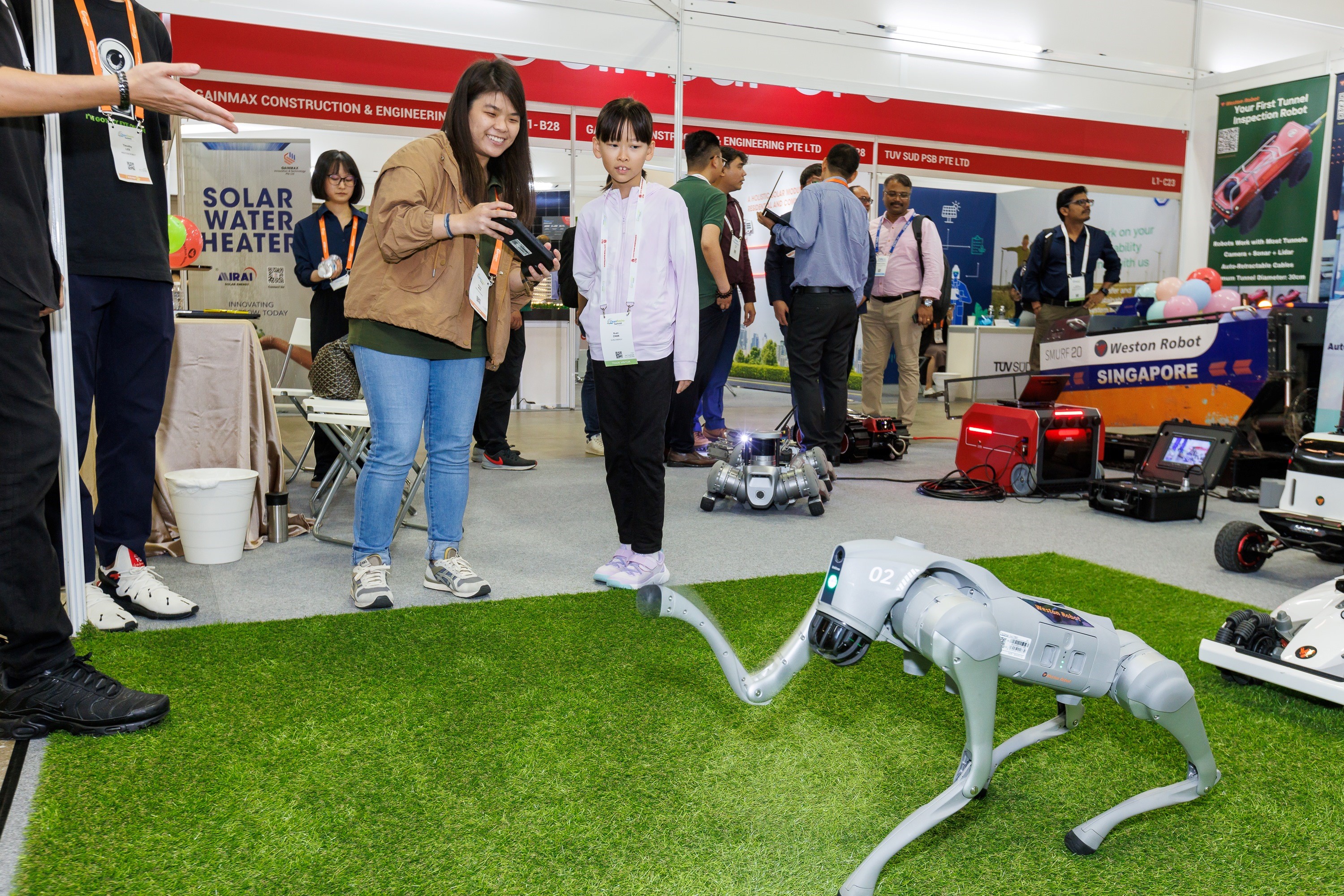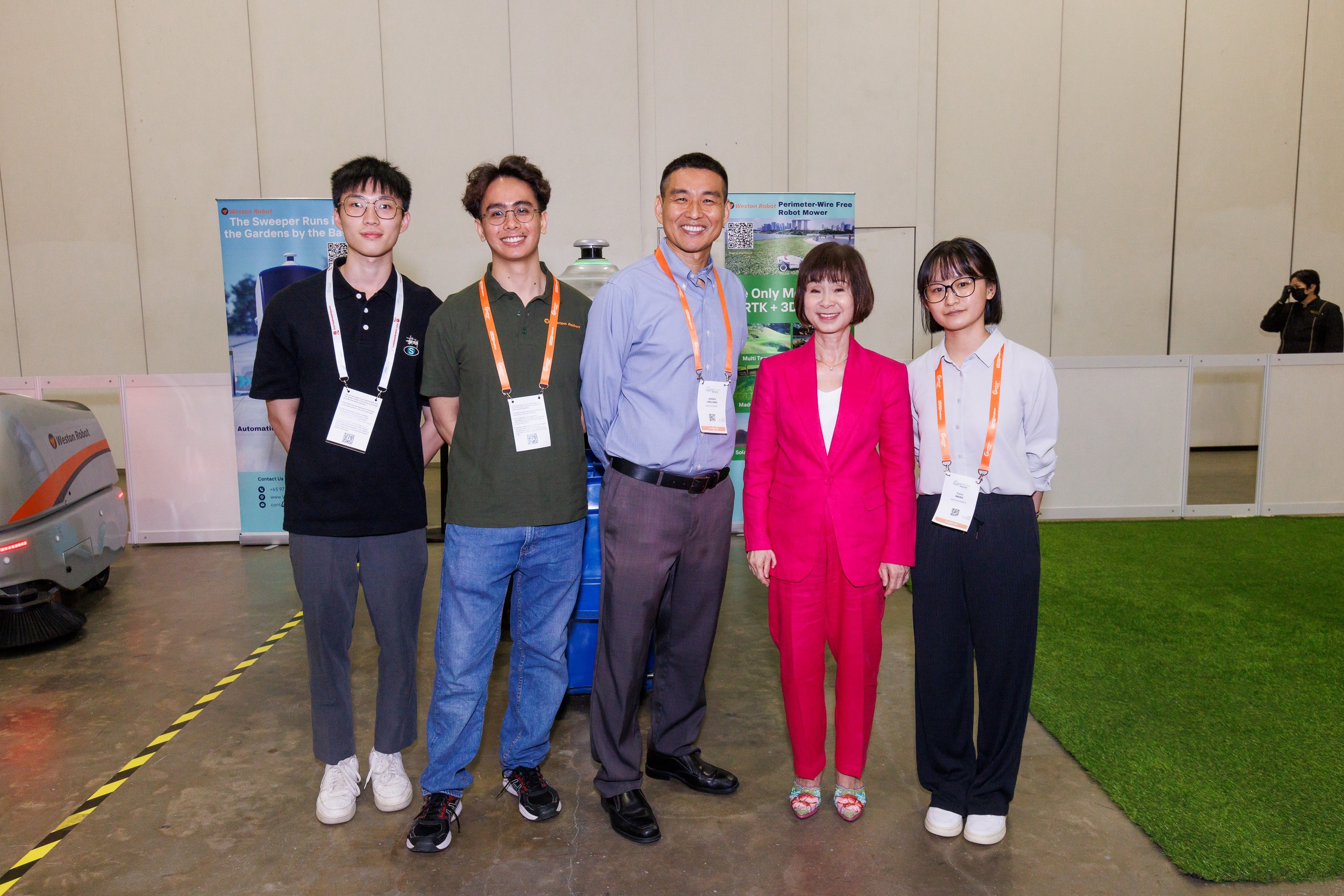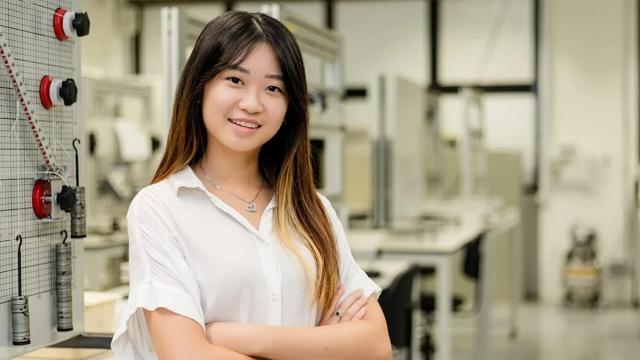SIT Robotics Systems students Sonia Mok, Timothy Lee, and Joshua Ng wowed their IWSP supervisors at Weston Robot with their deep skills and positive mindsets. They were so impressive that Weston Robot changed their hiring plans and offered them full-time positions after their graduation.

Sonia demonstrating Weston Robot‘s robotic dog to visitors at the CleanEnviro Summit Singapore 2024. (Photo: Weston Robot)
In January 2024, three Singapore Institute of Technology (SIT) students from the Robotics Systems degree programme embarked on their 12-month Integrated Work Study Programme (IWSP) at Weston Robot, without knowing what to expect.
Six months in, Sonia Mok, Timothy Lee, and Joshua Ng have proven themselves to be outstanding in their time at the robotics company which specialises in Robots as a Service (RaaS), developing core technology for robotics in three major categories – facility management, utility and transportation.
The three of them have immersed themselves fully in their IWSP experiences at Weston Robot, getting involved in all aspects of work in the firm, including programming, designing, testing, imaging, and presenting–and grown immensely from it all. As a testament to the students’ performance, Weston Robot has created new roles for them upon their graduation in 2025.
Said their supervisor, Mr Zhang Yanliang, Chief Scientist at Weston Robot, “Their extensive knowledge in robotics gained from project-based courses in their first and second years in SIT, and their exposure to industry-standard toolchains, workflows, and mindsets while at school have moulded them into ‘T-shaped’ individuals who are skilled and collaborative.”
Knowledge of Industry-standard Toolchains and Workflows
The trio remembered learning about Git – a distributed version control system that is used by developers to track file versions and enables developers to collaborate on projects during their first two years at SIT.

Joshua (2nd from left), pictured with Mr Zhang Yanliang (centre), Chief Scientist, Weston Robot, and Dr Amy Khor (2nd from right), Senior Minister of State for Transport and Senior Minister of State for Sustainability and the Environment at the CleanEnviro Summit Singapore 2024. (Photo: Weston Robot)
Back then, they were taught the basics of using Git and its usefulness, but never had to use it because of the controlled nature of projects they did while at SIT.
Working on actual projects at Weston Robot showed them the true value of systems like Git and suddenly the information they stored at the back of their minds came into play.
Shared Joshua, “I realised that my work would have a bearing on the larger project, leaving a real, lasting impact. That’s when I really learned why I needed to properly document all my code, so that my teammates and I could refer to it and problem-solve when issues inevitably cropped up.”
The early days were stressful, as Joshua and Timothy found themselves grappling with the rigour of documenting all the versions of their files on Git, which was time-consuming. But their introduction to the system while at SIT proved very useful, “because it meant we did not have to start our learning from zero,” said Timothy.
“Our exposure to industry trends when vendors came during our lessons, was also especially helpful as we navigated our projects at Weston Robot,” he said.
A Mindset of Constant Discovery and Learning
Working on real problems at Weston Robot also required the trio to dig deep and display resourcefulness, tenacity, and agility when facing things they did not immediately have answers to.
Explained Sonia, “Our SIT professors always advised that if we don’t know something, we can always look it up somewhere. Not everything is searchable on the internet or can be learned from simple DIY tutorials; it’s also important to take the time to read technical texts and documentation to fully understand how things work.”
Joshua agreed, adding that he had learned how to bridge information gaps by independently looking up information from trusted sources and databases, a skill he had learned from his professors.
This resourcefulness helped him when he was initially unable to find a template for a programme style guide he was creating. Instead of feeling stumped, he was unfazed and kept searching online.
He said, “I looked around and eventually found a programme – the Airbnb JavaScript Style Guide by Airbnb Engineering & Data Science. I decided to base my own style guide on theirs and it turned out well.”
Failure as an Opportunity to Grow
All in all, the IWSP experience is really unlike a traditional internship experience.
Shared Timothy, “We got to take on actual projects at Weston Robot and bring them to fruition; from getting the project started, to documenting the process, to seeing them implemented on actual products.”
One of the real tasks assigned to Sonia was to design a rain sensor. It seemed quite straightforward initially, until she realised that the clear-cut parameters of school projects did not exist there.
“No more controlled environments to make my job easier!” laughed Sonia. “The rain sensor would have to work in every environment, no matter what time, where, or how heavy the rain was.”
And of course, these real-life projects came with the inevitability of failure – a reality the trio had to grapple with at the start.
“Making mistakes in school is very different from making mistakes at work,” explained Joshua. “In school, our programmes fit into a box and the task is straightforward. Here, our programmes are part of a bigger product. The stakes are a lot higher because there are real-world implications to your mistakes.”
However, as the three of them discovered, failure is not only necessary but also welcomed as an agent of growth.
Said Sonia, “My supervisors encouraged me to be bold and not afraid to make mistakes, so that we could troubleshoot and come up with solutions sooner!”
This is precisely what the three SITizens want their juniors to know as they embark on their IWSP experiences: to be patient with failure and embrace the learning process.
Sonia summed it up succinctly, “Coming into my internship here (at Weston Robot), I realised that there was so much I still didn’t know and that I would fail. I learned how to build better things from failure.”
![[FA] SIT One SITizen Alumni Initiative_Web banner_1244px x 688px.jpg](/sites/default/files/2024-12/%5BFA%5D%20%20SIT%20One%20SITizen%20Alumni%20Initiative_Web%20banner_1244px%20x%20688px.jpg)

